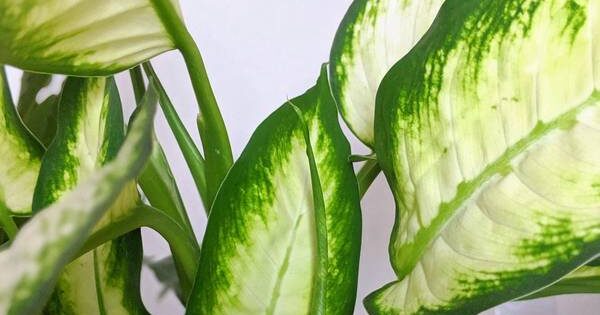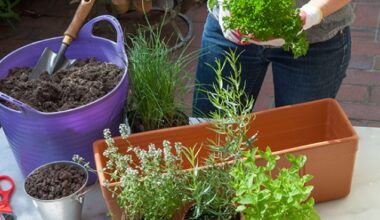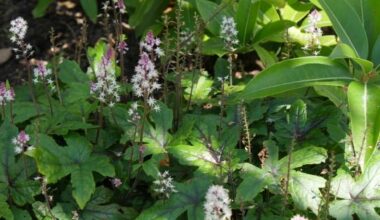Blooming in South America, the camille plant is a tropical plant that needs a lot of light. Nicknamed “cane of the dumb” because of the swelling of mouth which it causes if you consume its leaves, the camille plant will please as a house plant especially as it is easy to live.
Contents
Where to plant camille plant?
Until recently, camille plant was rather grown in greenhouses. The new varieties acclimatize better to the atmosphere of an indoor or veranda.
The best place to grow camille plant is near a window with good light transmission, but without direct sunlight. This plant fears the burning sun and tolerates the half-shade. In winter, it needs a bright light, and in summer a subdued exposure.
Avoid absolutely the cold temperatures, lower than 59 °F and the draughts, but also the proximity of a source of heat (radiator), because this plant of tropical origin needs moisture.
When and how to plant camille plant?
You can plant your subject all year round. However, prefer the spring period.
First of all, choose a plant with glossy foliage and no spots.
Make sure that the underside and axils of the leaves do not hide pests such as mealy bugs, which are very popular with this type of plant.
- Use a jar at least 8 inches in diameter, pierced at the bottom to allow good drainage of the irrigation water. The roots of the camille plant dread excess water.
- Spread a 2 inches layer of clay balls or gravel on the bottom of the pot.
- Add some nutrient-rich potting soil for houseplants.
- Place the plant without burying the collar.
- Fill in with the potting soil and slightly compact the area around the foot of the plant.
- Place the pot on a large bowl containing clay balls kept moist.
- Water after planting.
- Place the pot in bright light but without direct sunlight.
Cultivation and maintenance of the camille plant
Maintenance, repotting, watering or exhibition will make your camille plant even more beautiful:
- Regular, but moderate watering is necessary.
- Leaves should be cleaned often enough with a damp sponge to avoid dust accumulation.
In spring and summer
- Keep the potting soil moist and ensure proper water drainage.
- Apply liquid green plant fertilizer about every two weeks during this growing period.
- Spray the foliage regularly with preferably non-calcareous water during hot weather.
- Store the plant between 64 and 75 °F. At warm temperatures, high humidity is required. Grow the plants above a container of water filled with pebbles or clay balls.
- The camille plant likes slightly acidic compost.
- Repot the young plants every year in the spring in a mixture of heather soil and potting soil. When your plant is grown in a 8 inches pot, just renew the surface of the mixture. If you wish to have a larger plant, continue to repot it, but every 2 years, until you reach a 15 inches pot.
In fall and winter
- Water in the same way if the plant is in a well heated room (it will not take any rest period). If temperatures are lower than in the summer, reduce watering by keeping the compost barely moist.
- Stop all fertilizer application.
- Keep temperatures between 59 and 64°C. If temperatures are too low, lower leaves tend to fall.
Camille plant with yellows leaves, what to do?
Yellowing of leaves can have several causes. Among them, over-watering or too cool temperatures. But a yellowing camille plant can also be a sign that your indoor air is not moist enough.
You can install a mister in the room where the plant is located. Also avoid installing it near heat sources (radiators…) or in a draughty area.
Varieties of camille plant
Camille plant exists in more than thirty varieties. The majority of these beautiful perennials are integrated into the interiors of homes. The varieties that you buy in France come from the typical species, the Camille plant, formerly called Camille plant maculata.
The latter has a beautiful green foliage variegated with white. It is both the most common and the most toxic.
- Dieffenbachia (Camille plant) has beautiful veins with creamy areas on a dark green background. It has the peculiarity of having only one stem that turns into a trunk.
- The Dieffenbachia compacta has light green foliage with white and creamy mottling.
- The Dieffenbachia exotica has a very dark green foliage punctuated mostly by white to cream areas.
- The Dieffenbachia green magic has white veins on its green foliage, which gives it a special elegance.
- The Dieffenbachia reflector alternates light and dark green on a foliage that seems to be filled with veins made with a brush: amazing!
- The Dieffenbachia tropic snow has beautiful dark green foliage punctuated with cream-colored spots.
Camille plant diseases
Like many houseplants, the camille plant can suffer from certain common ailments.
- Red spiders are among the usual pests. Their action makes leaves yellow and you can tell if they are present by the webs they weave. To get rid of them, water, black soap and nettle manure are among the natural solutions. At the same time, increase the ambient humidity of the room in which the dumb cane is installed.
- Other frequent pests are the scale insects. Their action tends to create a white deposit on the foliage.
- If the leaves fall off, it means that they lack heat: you must therefore return to the right temperature for your camille plant.
- A loss of color or a small size of the foliage means that there is a lack of light. And as you know, it is its daily energy so it is up to you to find a brighter place for your plant.
Diseases, pests and parasites
Some symptoms may appear in poor growing conditions
- If the lower leaves fall off, your plant is cold. Place it in a warmer place at a temperature of at least 59°F or 61°F.
- If the lower leaves turn yellow, the plant has too much water. Let the compost dry until the plant recovers.
- If the leaves and stems rot and become viscous in places, it is either due to excess moisture or because the foliage has been wetted at too low temperatures. Use a fungicide or sprinkle the diseased parts of the flower with sulphur.
- If the new leaves are small, your plant lacks light. Move it near a window, while avoiding direct sunlight.
- If the leaves of white-spotted varieties have brown spots, it means that the plant has had too much fertilizer on too dry compost.
The camille plant can be the victim of several pests
- The presence of mealybugs results in white, woolly patches under the leaves. Remove them with a pad soaked in methylated spirits, release an active predator such as the ladybug (3 or 4 per plant) or spray with a systemic insecticide.
- Red spiders can attack the leaves, which turn yellow with filaments underneath. Treat with an acaricide and increase the humidity around the plant.









